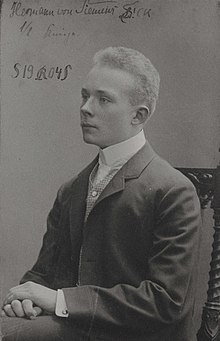Hermann from Siemens
Hermann Werner von Siemens (born August 9, 1885 in Berlin ; † October 13, 1986 in Munich ) was a German industrialist from the Siemens family . He was the oldest grandson of the inventor and company founder Werner von Siemens and the grandson of the physicist Hermann von Helmholtz .
Life
Hermann von Siemens was the eldest son of the entrepreneur Arnold von Siemens and his wife Ellen, née von Helmholtz. The industrial family came from the old Goslar city dynasty Siemens (mentioned in a document in 1384).
In 1904, Siemens began studying chemistry in Heidelberg and joined the Leonensia student union . After graduation and the doctorate to Dr. phil. von Siemens joined the company in 1918 as a technical employee of the physico-chemical laboratory of Siemens & Halske , Berlin. In 1928 he was appointed to the management board of Siemens & Halske AG, and one year later he took over the management of the central laboratory. There he made significant contributions to the development of telex technology . Before 1933 Siemens was a member of the German National People's Party . As head of the central technology department, he became a member of the Managing Board of Siemens-Schuckertwerke AG in 1935 .

In 1941 he succeeded his late uncle Carl Friedrich von Siemens as chairman of the supervisory board of the two parent companies Siemens & Halske and Siemens-Schuckertwerke and thus as “head of the house”. Until 1945 he sat on the supervisory board of the United Steelworks , the Mannesmannröhren-Werke , Krupp and Deutsche Bank . During the Second World War , the Reich government ranked him among the " military economic leaders ". During the war, over 400 Siemens production facilities were relocated to avoid bombing by the US and British air forces.
He was arrested on December 5, 1945 and questioned in “Civil Internment Camp No. 91”, saying that as a witness he was “very unwilling and evasive”. Siemens-Schuckert had been assigned slave labor inside and outside of concentration camps for war production. Nonetheless, no charges were brought at the Nuremberg trials , as no personal misconduct could be ascertained. In 1948, Hermann von Siemens was able to take over the two chairmanships of the supervisory board, which he temporarily ceded to his uncle Friedrich Carl Siemens (1877–1952), a son of Friedrich Siemens , from 1946–48 .

In the position that he held until 1956, Hermann von Siemens gave the company important impetus for its reconstruction after the Second World War. Because of the Berlin blockade , in 1947 the company relocated the headquarters of Siemens & Halske AG from Berlin to Erlangen, where the Siemens-Schuckert production facilities were located, and in 1949 to Munich, where the Ludwig Ferdinand Palace on Wittelsbacher Platz was initially rented and in 1957 for the Headquarters was acquired.
Hermann von Siemens, personally of a rather introverted nature and with strong scientific interests, was particularly committed to promoting scientific and technical research inside and outside the company, for example he was President of the Fraunhofer Society from 1955 to 1964 . He was also involved in the Helmholtz Fund eV, which has been awarding the Helmholtz Prize for scientific and technological research work in metrology since 1973 .
His successor as "head of the house" was his cousin Ernst von Siemens in 1956 . Hermann von Siemens remained an honorary member of the Supervisory Board until his death at the age of 101 in 1986. On June 23, 1962 he was awarded the Bavarian Order of Merit.
Hermann von Siemens was married to Charlotte von Maltzan , Freiin zu Wartenberg and Penzlin; the couple had six children. After the Second World War, he moved his residence from Berlin to Munich at the same time as the headquarters of Siemens. He donated the Siemens villa built by his parents on the Kleiner Wannsee in Berlin to the Baptist congregation in 1950. In the Rhineland he owned the Haus Lerbach estate .
literature
- Shaping the future. The Siemens entrepreneurs 1847–2018. Published by the Siemens Historical Institute, Hamburg 2018, ISBN 978-3-86774-602-1 .
- Hermann from Siemens. In: Wilfried Feldenkirchen, Eberhard Posner: The Siemens entrepreneurs. Continuity and change 1847–2005. Ten portraits. Munich 2005, ISBN 3-492-04801-3 , pp. 112–129.
Web links
- Hermann von Siemens in the Munzinger archive ( beginning of article freely accessible)
Individual evidence
- ↑ For a short biography, see the investigation documents prepared by the US military government in 1946/1947 to initiate a war crimes trial against Deutsche Bank. They were translated and published in 1985: Hans Magnus Enzensberger (Ed.): Investigations against Deutsche Bank: 1946/1947 / Military government d. United States for Germany, Finance Department, Sect. For Financial Research. Trans. U. edit from D. Documentation Center for Nazi policies, Hamburg, Nördlingen: Greno, 1985, ISBN 3-921568-66-8 , pp 338-352.
| personal data | |
|---|---|
| SURNAME | Siemens, Hermann von |
| ALTERNATIVE NAMES | Siemens, Hermann Werner von (full name) |
| BRIEF DESCRIPTION | German industrialist and grandson of Werner von Siemens |
| DATE OF BIRTH | August 9, 1885 |
| PLACE OF BIRTH | Berlin |
| DATE OF DEATH | October 13, 1986 |
| Place of death | Munich |

